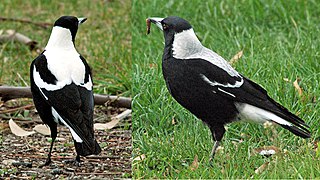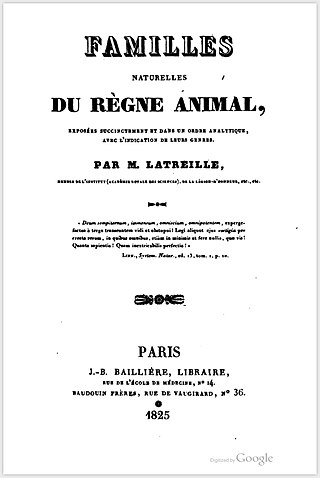
The Australian magpie is a black and white passerine bird native to Australia and southern New Guinea, and introduced to New Zealand. Although once considered to be three separate species, it is now considered to be one, with nine recognised subspecies. A member of the Artamidae, the Australian magpie is placed in its own genus Gymnorhina and is most closely related to the black butcherbird. It is not closely related to the European magpie, which is a corvid.

Cicadas of the genus Neotibicen are large-bodied insects of the family Cicadidae that appear in summer or early fall in eastern North America and formerly Bermuda. Common names include cicada, harvestfly, jar fly, and the misnomer locust.

The Aspredinidae are a small South American family of catfishes also known as the banjo catfishes, with about 43 species.

The badge on the Flag of South Australia depicts the rising sun, and a Piping Shrike standing on a branch of a gum tree. The Piping Shrike is more commonly known as a White-backed Magpie.

The black-headed oriole is a species of bird in the family Oriolidae. It is found in Africa and has a very striking appearance with a bright yellow body, contrasting black head and flesh-coloured beak.
Tibiceninae is a historical subfamily name from the insect family Cicadidae. It was first used by Distant (1889). As of 2021, the name became unavailable to zoological nomenclature due to the suppression of its type genus Tibicen Berthold, 1827 by the International Commission on Zoological Nomenclature. Cicada genera grouped at the subfamily level with genus Lyristes are generally referenced under the name Cicadinae Latreille, 1802.

The black butcherbird is a species of butcherbird in the family Artamidae. It is found in Australia, Indonesia, and Papua New Guinea. Its natural habitats are subtropical or tropical dry forest, subtropical or tropical moist lowland forest, and subtropical or tropical mangrove forest.

Aspredo aspredo is the only species of banjo catfish in the genus Aspredo.

Platystacus cotylephorus, the banded banjo, is a species of banjo catfish. It is the only member of its genus. The genus Platystacus is the sister group to a clade containing Aspredo and Aspredinichthys. P. cotylephorus originates from coastal waters and lower portions of rivers of northern South America, from Venezuela to northern Brazil.
Aspredinichthys is a genus of banjo catfishes found in fresh and brackish waters in tropical South America from the Orinoco delta, through the Guianas, to the Amazon delta. Both species are found in lower portions of rivers and in coastal waters of northern South America from Venezuela to northern Brazil where they are benthic fish.

Centropyge tibicen, the keyhole angelfish, black angelfish, whitespot angelfish or puller angelfish, is a species of marine ray-finned fish, a marine angelfish belonging to the family Pomacanthidae. It is found in the Indo-Pacific region.
Aspredinichthys filamentosus, the sevenbarbed banjo, is a species of banjo catfish found in coastal brackish waters and coastal rivers in South America from Venezuela to Brazil including the island nation of Trinidad and Tobago. The species practices an unusual method of incubation of the eggs, attaching them to the underside of the female who then carries them around.

Annual cicadas are North American Cicadidae species that appear every summer. The life cycle of a so-called annual cicada typically spans 2 to 5 years; they are "annual" only in the sense that members of the species reappear annually. The name is used to distinguish them from periodical cicada species, which occur only in Eastern North America, are developmentally synchronized, and appear in great swarms every 13 or 17 years. All other cicadas from all other biogeographic regions produce annual broods, so the distinction is not made outside of North America.

Sphecius grandis, also called the western cicada killer, is a species of cicada killer wasp (Sphecius). The western species shares the same nesting biology as its fellow species, the eastern cicada killer. S. grandis, like all other species of the genus Sphecius, mainly provides cicadas for its offspring. It forms nest aggregations and mates and broods once in a year, in July and early August. The wasp is on average 3 cm (1 in) to 5 cm (2 in) in length and is amber-yellow with yellow rings on its abdomen.

The Australian magpie is a medium-sized black and white passerine bird native to Australia and southern New Guinea. Three subspecies, including both black-backed and white-backed magpies, were introduced to New Zealand from the 1860s to control pests in pastures. They are now spread through much of the two main islands of the country.

Neotibicen tibicen, known generally as the swamp cicada or morning cicada, is a species of cicada in the family Cicadidae. It is widespread across much of the eastern and central United States and portions of southeastern Canada. There are two subspecies, N. tibicen tibicen and N. tibicen australis, with the latter replacing subspecies tibicen in portions of Florida, Georgia, and Alabama.

Tibicen is a historical genus name in the insect family Cicadidae that was originally published by P. A. Latreille in 1825 and formally made available in a translation by A. A. Berthold in 1827. The name was placed on the Official Index of Rejected and Invalid Generic Names in Zoology by the International Commission on Zoological Nomenclature in 2021. Certain European cicada species that were included by some authors in this genus at the time of its suppression are now listed under genus Lyristes Horváth, 1926. Other formerly-Tibicen species are placed in the tribe Cryptotympanini and include the genera Auritibicen Lee, 2015, Hadoa Moulds, 2015 Megatibicen Sanborn and Heath, 2016, and Neotibicen Hill and Moulds, 2015.

Neotibicen lyricen, the lyric cicada, is a species of cicada in the family Cicadidae.

Neotibicen pruinosus, commonly known as the scissor grinder, is a species of cicada in the family Cicadidae.

The Elderslie Banksia Scrub Forest is a critically endangered scrubby woodland situated in southwestern Sydney, New South Wales, Australia. Listed under the Environment Protection and Biodiversity Conservation Act 1999, it is a variety of stunted forest or woodland found on sandy substrates associated with deep Tertiary sand deposits, which has been reduced in extent of at least 90% of its original pre-European extent.















